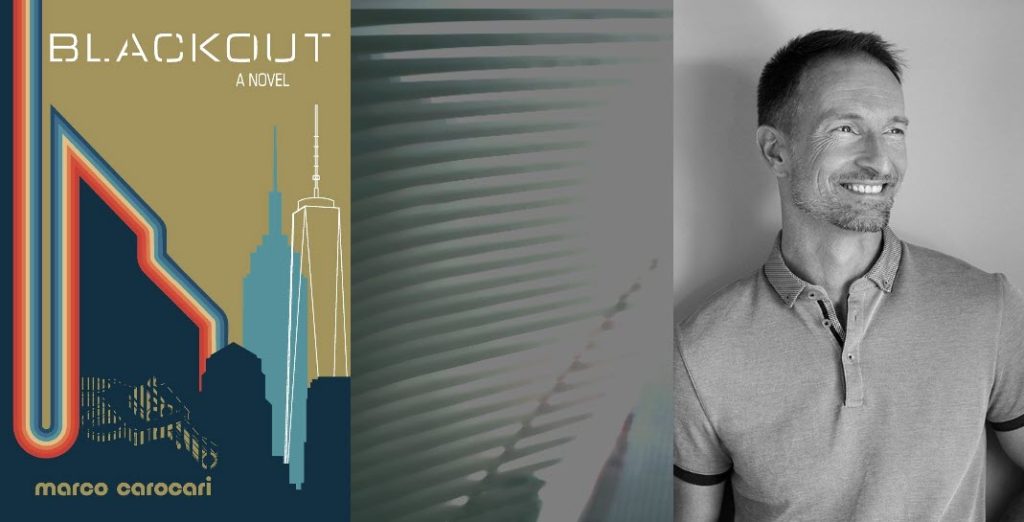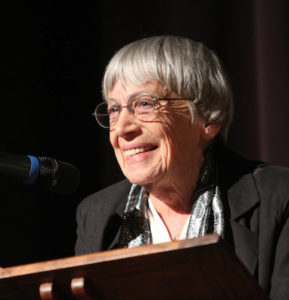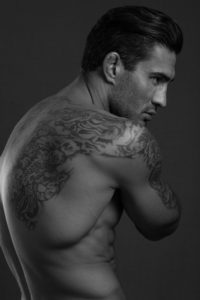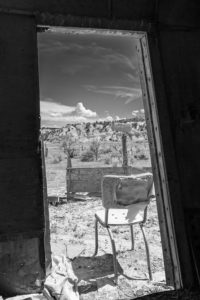
“Having taken an end of year writing break I picked up ‘Blackout,’ read the first scene, and literally had to set the book down again. The setting so vivid; the energy an exquisite blend of melancholy and intensity; and a man so real and so briefly on the stage before me.”
It always strikes me when a book I hadn’t thought would strike me does. Especially when it is something I might not typically read. I love me a well-done mystery (not cozy though, thank you) but crime thrillers just don’t do it for me. Nor do roller coasters, horror movies, or watching a car accident happen before my eyes (which has happened three times, once somewhat gruesomely). I guess you could say I don’t do adrenaline very well.
And in some ways I don’t do reading very well. It’s extremely difficult for me to lose myself in a book. My entire professional life involved reading and analyzing text. Twice—once after finishing my master’s written comps exam in English then again after completing my doctoral comps—I was unable to read for pleasure for nearly eight months. Add to that years of book and database indexing where the sole purpose was to dissect content into its informational parts and labels; and years of teaching writing where my job was to help students work out how to express their ideas in clear, correct, focused prose.
Photography by Marco Carocari
So why did I immediately preorder Marco Carocari’s Blackout? [1]
The cover art, for one. Having been an assistant manager in a bookstore I tend to be immune to (or perhaps bored by is the better phrase) the often generic, repetitive designs. But the art by Mark Gutkowski, with its Art Deco echo, the NYC then-and-now silhouettes, and the colors—khaki, midnight blue, and rainbow flashing—caught my own artist’s eye and sensibility. Second, author Carocari is also a photographer whose work manifests technical rigor, intense focus, and artistic intimacy. [2] My own approach as a writer is to relentlessly visualize. If I can’t see a scene, can’t see the people moving about, I simply cannot write it.
THE STORY
Here is the overview of Blackout from Carocari’s website:
Power, Precision, and Place
I don’t know why it took me this long to read Blackout—the book came out in March 2021. I am myself writing just now (a character-driven academic mystery as well as an involved speculative SF thing simmering alongside) and am one of those writers who dare not read certain other things when writing. I had a feeling Carocari’s book was one of them.
This is a compliment (I think) that I flinch at the potential power or influence of another’s work. Fiona Erskine’s Phosphate Rocks is sitting within my line of sight as I type this, also unread beyond the first few pages—those read thrice but no more than that, though her time is soon. [3] It’s a kind of respect in my universe to not want to read certain books until the moment is right.
Reader, this was such a moment. Having taken an end of year writing break I picked up Blackout, read the first scene, and literally had to set the book down again. The setting so vivid; the energy an exquisite blend of melancholy and intensity; and a man so real and so briefly on the stage before me. I was immediately caught by what I tweet-commented as the “quick, dark, graceful writing.”
And precise . . . which didn’t surprise me given the quality of Carocari’s photographic eye.
I’ve only been to New York City once and as a well-grown adult and even then for only two days. With the exception of similarly brief visits to London in the early 80s and San Francisco in the 90s, I’d never felt so immediately at home as I did in NYC. Reading Blackout gave me that same sense of familiarity and, in a way, of coming home. He didn’t have to world build for me. I was there! Sights, smells (the smells!), the pitch dark of the 1977 blackout, even the concrete beneath my feet.
HANGING TEN
 When I was a kid someone told me that waves always come in sevens with the last, seventh wave being the largest. I can remember sitting on the sandy edge of a small lake when summer-swimming with family, sitting and counting the waves as they came in. Maybe the theory doesn’t work in small lakes. I can only recall watching and watching as the rippled lines all looked the same as they hit the shore.
When I was a kid someone told me that waves always come in sevens with the last, seventh wave being the largest. I can remember sitting on the sandy edge of a small lake when summer-swimming with family, sitting and counting the waves as they came in. Maybe the theory doesn’t work in small lakes. I can only recall watching and watching as the rippled lines all looked the same as they hit the shore.
That image came to mind when reading Blackout, though here the waves did increase. I had this wonderful sense of being aboard a small boat or surfboard atop as each wave of the narrative pushed forward, rushing towards the shore with increasing intensity. Writer-Me noted “Oh, this is what they mean by a thriller.” Reader-Me just hung on surfer-like, for the ride.
Music is powerful element in Blackout and adds to the crescendo effect. Main character Franco DiMaso works at a club as one of his three jobs. There’s a lot of dancing and a lot of throbbing beats that surround the Franco and his friends. Although set in 2016, the musical vibe carried me back to when I was nineteen and first really fell in love; when I met my boyfriend’s gay friends who were the first out gay men I’d ever met; when I came into being in a way. The music of the Blackout’s characters and the deep sensibility that their music was the book’s own soundtrack gave me that sweet time back again. (Carocari includes a playlist at the end of the book and I have to say I wanted to hug him for that!)
The personable and the real
 Invariably I read books on multiple levels, some of which have little to do with what the book is literally about in terms of plot or genre. That happened reading Carocari where I jumped both.
Invariably I read books on multiple levels, some of which have little to do with what the book is literally about in terms of plot or genre. That happened reading Carocari where I jumped both.
Blackout is as far away from speculative science fiction as you can get. Composing my thoughts for this post I was rather surprised, then, that two books insisted on resonating alongside: Ursula K. Le Guin’s The Dispossessed and The Left Hand of Darkness. [4, 5] Here are short descriptions for each:
The Dispossessed (1974): “This novel is about the radically different societies on two close planets. On Urras, there are multiple states, each with their own government. On Anarres, there is no government or economic system. Shevek, a physicist on Anarres, wants to break the rules of his world and travel to Urras, not only to speak with other physicists who understand and are excited by his theories, but to promote friendship between the two planets. . . . ‘ The Dispossessed’ is a novel of anarchy and individualism, of utopias and paradise.” (From Bookrags; link below)
The Left Hand of Darkness (1969): “The novel follows the story of Genly Ai, a human native of Terra, who is sent to the planet of Gethen as an envoy of the Ekumen, a loose confederation of planets. Ai’s mission is to persuade the nations of Gethen to join the Ekumen, but he is stymied by a lack of understanding of their culture. Individuals on Gethen are ambisexual, with no fixed sex; this has a strong influence on the culture of the planet, and creates a barrier of understanding for Ai.” (From Wikipedia; link below)
I say just now I was rather surprised, more like baffled. My goal of getting this essay posted earlier this week was put on pause while I let the matter marinate. Finally what surfaced had little to do with the plots or genres of the three books and everything to do with two critical notions: the especial connections people make with each other and the authenticity of persons.
I mentioned that crime thrillers aren’t my jam. Blackout almost went on my did-not-finish book stack at the moment Franco has to identify a body in a morgue. My reaction was pretty much the same as his and I wasn’t sure I could go on, much as I wanted to find out what happened. What kept me going was what kept Franco going: the anchor he finds in the tight, eclectic circle of his friends. Shevek and Ai, the central characters in Le Guin’s two books are similarly grounded and literally saved, emotionally and physically, by core friendships.
In all three books the friendships have been nurtured over time, challenged by events, and in the end, solidified into what is colloquially referred to these days as found family. I kept expecting Franco’s friends to offload him for his stubborn and occasionally flakey behavior but they never do. Shevek, who comes close to suicide through a combination of intellectual pride and loneliness, is saved by a long ago friend who has conquered his own pride and who offers the salve of love and friendship. Ai’s inability to see beyond his default male template of sex and gender nearly derails his mission as Envoy, a mission saved by the sacrifice of a person Ai later realizes was his only and dearest friend.
Franco, Shevek, and Ai, all male in this instance, are in the end fundamentally and authentically themselves, respectively gay, cis-but-sexually-open, and cis. This I think is the doorway connecting the three books in my mind; not the gender/sexuality specifically, but the solidity of the respective identities and how Carocari and Le Guin write them as normative.
My voice has always been my own so to read a story with a very strong voice is deeply satisfying to me, no matter what the voice. Though the thriller aspect of this book will not stay with me I think, in terms of representation this is a book that I will cherish. I am not any of the people in it and though not gay specifically, I am other. Aside from the story, aside from the writing, I felt seen in a way I rarely experience in daily life. These people, Franco and his friends, were my people. There aren’t too many books that give me that.
Postscript: I deliberately did not read any reviews of Blackout or interviews with Carocari prior to reading his book. Finding out now that he is not native-born or raised American and managed to capture NYC as he did is some kind of wonderful. A tip of the cap to you, sir.
If you have a question or comment for me, drop me a line via my Contact page.
© J.A. Jablonski 2022. All rights reserved.
ABOUT BOOK THOUGHTS
“Book Thoughts” is an intermittent column within my blog. The essays are not so much book reviews as book responses. I like to converse with and around the books I read.
How to cite this post
Jablonski, J.A. (2022, Jan 6). Marco Carocari | Blackout. Blog post. J.A. Jablonski (website). https://jajablonski.com/2022/01/06/carocari_blackout
IMAGE CREDITS
Header image
-
- Cover of Marco Carocari’s book, Blackout. From Amazon.
- World Trade Center, NY. Photo by Lukas Blaskevicius on Unsplash. Modified & retinted.
- Marco Carocari. Author photograph. From Mr. Carocari’s photography website About page.
Ocean waves. Photo by Photoholgic on Unsplash
Photography by Marco Carocari: Man in profile with tatoos; Roy’s Motel; View of desert from RV trailer door. All used by permission.
Photo of author Ursula K. Le Guin © 2014 by Jack Liu. See Le Guin’s Publicity Photos page.
SOURCES
Disclaimer: As a Bookshop Affiliate (US only) I will earn a commission if you click through on a book title I’ve linked to and make a purchase.
[1] Carocari, Marco. (2021). Blackout. Level Best Books. His author website is here.
[2] Carocari, Marco. Mr. Carocari’s photography website.
[3] Erskine, Fiona. (2021). Phosphate Rocks: A Death in Ten Objects. Sandstone Press. ISBN: 9781913207526
[4] Le Guin, Ursula K. (1974). The Dispossessed. Avon Books. (Bookshop link is to the Harper Voyager 1994 edition.) The Bookrags quotation above can be found here.
[5] Le Guin, Ursula K. (1969). The Left Hand of Darkness. Ace Books. (Bookshop link is to the Ace Books 1987 edition.) The Wikipedia quotation above can be found here.





